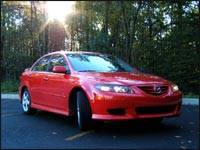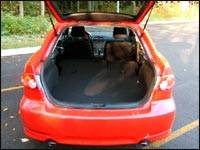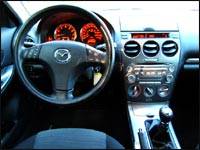Zooming midsize MazdaThe Mazda 6 is the replacement of the ill-fated Mazda 626 (1998-2002). This last design of the 626 never achieved the commercial success that the previous two generations did. Mazda decided in 2003 that it wanted its fair share of this very large portion of the market. Enter the
2004 Mazda 6. Launched in early 2003 as the sporty alternative in the segment, it made promises of handling, style, performance and driving pleasure. In the course of 2004, Mazda introduced the hatchback and wagon versions to complete the line-up. This car, being the third Mazda 6 that I have tested, has left me with as many questions as it has with answers. I have driven a manual GS-I4 sedan as well as a manual V6 GT-GFX sedan. The biggest difference between all 3 was with respect to handling and braking, specifically between the 4 and 6 cylinder engines (engine power notwithstanding). The tester was Sport V6 with the manual transmission and the GFX package. It retails for 30 760$
Exterior styling |
| The 6 has tidier exterior dimensions, flowing lines and almost looks like it is going fast even when it is parked. (photo: Mathieu St-Pierre, Auto123) |
In this segment, there are the Camrys, the Accords, the Tauruses, etc. All these cars are large and generally devoid of character. They all offer a cavernous cabin but they all lack a certain "je ne sais quoi". The 6 has tidier exterior dimensions, flowing lines and almost looks like it is going fast even when it is parked. Sharp taillights and headlight, a dual exhaust tip setup and deep front air dam convey an athletic and aggressive edge to the car. When the loaner was stationary, its Bright Red colour almost made it look like a 4 door Ferrari. I had noticed that the door panels on the Mazda 3 were very thin. I am pleased to say that the 6 has thicker steel and should resist denting a little better. Paint application (with the exception of some orange peel) and panel assembly are generally good.
Interior stylingA driving position is easily found as there are many adjustments possible. The front seats are cosy enough however they lack lateral support. A note about the seat materials: the driver seat left bolster in the tester displayed some important signs of wear that make me wonder about the quality of the cloth material over the long haul. This 6 only had 12 500 km indicated on the odometer; I am somewhat concerned as to what the condition of the fabric will be after 5 years of wear and tear. The instrument cluster houses large chrome-rimed gauges. The speedo and tach needles light up, and when they do, the light reflects on the chrome rings. The interesting part about this comment is that the reflection for the tachometer is towards the redline from the needle and the one for the speedometer is from 0 to the indicated speed.
 |
Interior fit and finish is quite good. The centre-stack of the dash is certainly packed with style, but at a quick glance it can sometimes be confusing to differentiate between the radio and climate controls. One area which I found myself asking questions was concerning some rattles. I cannot recall hearing any interior noises in the first 2 sedans. The Sport, on the other hand, had a few too many; this was possibly due to the hatch. Speaking of the hatchback, if the trunk of the sedan is deep and wide then the Sport's seems like the equivalent of a swimming pool. The large opening unlocks a whole new world of utility and ease of use.





